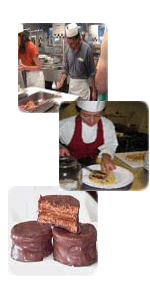




|
As a supplement to our Italian language courses, we also offer Italian cooking courses for professionals and for non-professionals
Professional Cookery Courses
For those interested in a professional career as a chef, pizza maker, pastry chef, gourmet or sommelier, the school offers the possibility to attend professional courses at an High Italian cooking school. The courses are available on request only for schools and groups (at least 10 people).
All of our courses are based around fundamental cookery techniques and methods that can be applied whether you’re working in a professional kitchen or entertaining at home.
Everything we do at the cookery school is underpinned by a desire to promote food that has been grown in a way that is sustainable, environmentally sensitive, ethical and supportive of local business.
We offer:
Professional catering courses
Pastry chef
Fish, shells and cold dishes in Apulia cuisine
Pasta, Soups and Risotti and Apulia cuisine
Cakes
Non-Professional Cookery Courses

Salentinian Cooking Courses
For those who love Italian food and want to learn to prepare traditional Italian or Salento typical dishes (appetizers, pasta, meat, fish, "macaronies and suricles, sagne, parmigiana",vegetables, pizza, desserts, etc.), "ILS" offers a practical small group course.
These courses can be booked in advance and can take place at any point in the year. The number of meetings will be decided by the student.
These courses must be combined with a Italian language courses of ours.
Italian, Apulian and Salentine Gastronomy
Spaghetti with Seafood
Seafood pastas are basics of Italian gastronomy, but vary enormously from region to region: the spaghetti vongole from Naples, the Venetian black spaghetti with cuttlefish, pasta with mussels and limpets from Positano and spaghetti and sea urchins from Puglia. The most important thing to remember is that the seafood must be the very freshest possible. It is the liquid the clams or mussels produce in cooking that contributes .....
The Turcinieddhri
All people are crazy for the turcinieddhri, the olives of the bowles of the suckling calfs, that are refined and, at the same time, bitterish.
It is employed only the bowels of suckling calfs to make the turcinieddhri. the sucking calfs must never graze.
Their preparation is very simple. The bowles are washed with the water. Then, after having put them for a few hours in the water and lemmon juce, they are stuffed with the animals internal organs like the heart, the lungs and the liver, minced. It is make use of the fat, that winds the lamb's stomac: the peritonaeum membrane. With a little of parsley and salt, the turcinieddhi are ready to be grilled. In the restaurants they are very required. But also the families in their home eat a lot of turcinieddhri, especially in the week-end.
In the nearly all Salento, their name is turcinieddhri. But in some countries their name is gnomarieddhi. The Salento's turcinieddhri are short .....
Wild Mushroom Crostini
This Italian dish is extremely popular because of its versatility: it can be served as a snack or an antipasto,or with drinks. Crostini can be topped with chicken liver patè, a mixture of tomato, mozzarella and basil, or grilled vegetables. This version using wild mushrooms is exceptionally good - even if you can't get hold of any wild mushrooms and have to use cultivated instead. For the photograph we used chicken of the wood, horn of plenty, brown caps or chestnut .....
The Scapece ..... But what is the scapece?
It is a typical recipe of Gallipoli, made with little fishes.
The fishes are fried in olive-oil and covered with bread crumbs, vinegard and saffron.
The scapece is often eaten with the celery. Infact often the celery's sellers are near the scapece's sellers.
It is an unique sensation to associate the sweet taste of the celery with the strong of .....
|

